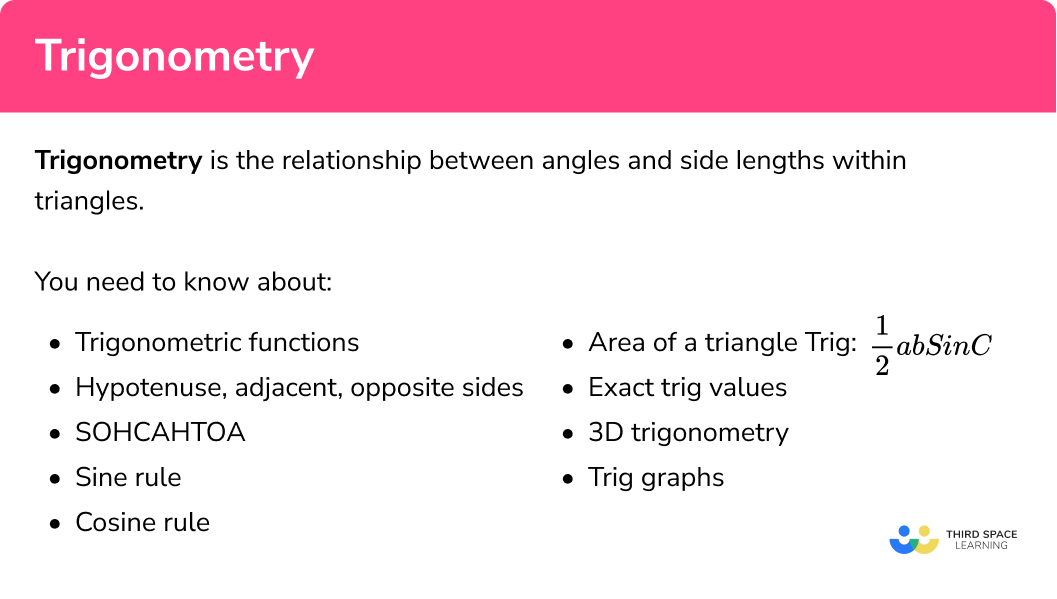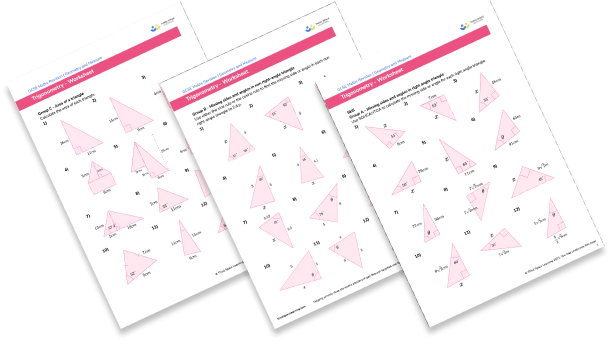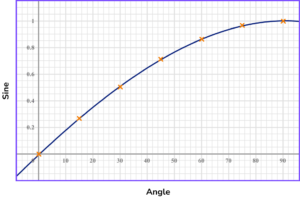GCSE Tutoring Programme
Our chosen students improved 1.19 of a grade on average - 0.45 more than those who didn't have the tutoring.
In order to access this I need to be confident with:
Angles in a triangle Area of a triangle Rearranging equations 2D shapes 3D shapes Pythagoras TheoremThis topic is relevant for:

Trigonometry
Here we will learn about trigonometry including how to use SOHCAHTOA, inverse trigonometric functions, exact trigonometric values and the hypotenuse. We’ll also learn about the sine rule, the cosine rule, how to find the area of a triangle using
There are also trigonometry worksheets based on Edexcel, AQA and OCR exam questions, along with further guidance on where to go next if you’re still stuck.
What is trigonometry?
Trigonometry is the relationship between angles and side lengths within triangles; it is derived from the greek words “trigōnon” meaning triangle and “metron” meaning measure.
Trigonometry was originally used by the Babylonians, over
The higher GCSE curriculum expands the use of trigonometric functions for non right-angle triangles, developing from the fundamental knowledge of the three trigonometric ratios (expressed as the mnemonic SOHCAHTOA) and exact trigonometric values in right angle triangles.
See also: 15 Trigonometry questions
What is trigonometry


Trigonometry worksheet

Get your free trigonometry worksheet of 20+ questions and answers. Includes reasoning and applied questions.
DOWNLOAD FREE
Trigonometry worksheet

Get your free trigonometry worksheet of 20+ questions and answers. Includes reasoning and applied questions.
DOWNLOAD FREESOHCAHTOA
What is SOHCAHTOA?
SOHCAHTOA is the abbreviation used to describe the three trigonometric ratios for the sine, cosine and tangent functions.
To determine which trigonometric function you need to use to answer a question, it depends on the location of the angle and the sides of the triangle that will be used.
The trigonometric functions apply to right-angle triangles.
- If you know the hypotenuse and the opposite side of the angle, you would use the sine function.
- If you know the hypotenuse and the adjacent side (next to) the angle, you would use the cosine function.
- If you know the opposite and adjacent sides to the angle, you use the tangent function.
We can use SOHCAHTOA to calculate lengths and angles in 2D and 3D shapes by recognising right-angle triangles.
E.g.
We can find the length
Step-by-step guide: SOHCAHTOA
Hypotenuse
What is the hypotenuse?
The hypotenuse is the longest side of a right angle triangle. It is the side opposite the right angle.
The hypotenuse does not occur for other types of triangles unless we know more information (such as an isosceles triangle can be made from 2 identical right angle triangles, back-to-back).
Labelling the other sides of the triangle
Once we know which angle we are using, we can label the sides opposite
We know the hypotenuse is opposite the right angle.
The opposite side is opposite the angle we are using.
The adjacent side is next to the angle we are using.
The triangle below is labelled based on using the angle
Step-by-step guide: Hypotenuse
Example 1: find a side given the angle and the hypotenuse
Calculate the value of
Labelling the sides
Inverse trigonometric functions
What are inverse trigonometric functions?
Inverse trigonometric functions allow us to calculate the size of angle
The inverse trigonometric functions look like this:
| Sine | Cosine | Tangent | |
|---|---|---|---|
| Trigonometric
Function | \sin(\theta) = \frac{O}{H} | \cos(\theta)=\frac{A}{H} | \tan(\theta)=\frac{O}{A} |
| Other Forms | H=\frac{O}{\sin(\theta)} O=H\times\sin(\theta) | H=\frac{A}{\cos(\theta)} A=H\times\cos(\theta) | A=\frac{O}{\tan(\theta)} O=A\times\tan(\theta) |
| Inverse
Trigonometric Function | \theta=\sin^{-1}(\frac{O}{H}) | \theta=\cos^{-1}(\frac{A}{H}) | \theta=\tan^{-1}(\frac{O}{A}) |
Step-by-step guide: Trigonometric functions
Example 2: find the angle using inverse trigonometric functions
Calculate the size of angle
The two sides that can be used to calculate the value of
In order to calculate
We therefore have:
Exact trigonometric values
What are exact trigonometric values?
Exact trigonometric values are found when the relationship between the sides and the angles in a triangle have a specific relationship.
Summarising these values, we obtain the exact trigonometric values for sine, cosine and tangent for
Example 3: using exact trigonometric values
We therefore have the triangle:
Using the table above,
Pythagoras or trigonometry?
We need to be able to interpret problems and recognise whether we need to use Pythagoras’ Theorem in
This flow chart describes the information you need to know about a shape in order to solve the problem.
It is important to recognise that with most of these problems, you may need to use the Pythagorean Theorem, or trigonometry, or both within the same question so you must be confident with these topics individually to access this topic fully.
Below is a summary of methods that can be used for right angled triangles:
| Name | Used to find… | Rule or Formula |
|---|---|---|
| Pythagoras’ Theorem in 2D | The hypotenuse (c) A shorter side (a) Whether the triangle contains a right angle or not | c=\sqrt{a^{2}+b^{2}}
a=\sqrt{c^{2}-b^{2}} a^2 +b^2=c^2 |
| Sine Function | Missing side: Hypotenuse (H) or Opposite (O) | H=\frac{O}{\sin(\theta)}
O=H\times\sin(\theta) |
| Cosine Function | Missing side: Hypotenuse (H) or Adjacent (A) | H=\frac{A}{\cos(\theta)}
A=H\times\cos(\theta) |
| Tangent Function | Missing side: Adjacent (A) or Opposite (O) | A=\frac{O}{\tan(\theta)}
O=A\times\tan(\theta) |
| Inverse Sine Function | Missing angle (\theta) | \theta=\sin^{-1}(\frac{O}{H}) |
| Inverse Cosine Function | Missing angle (\theta) | \theta=\cos^{-1}(\frac{A}{H}) |
| Inverse Tangent Function | Missing angle (\theta) | \theta=\tan^{-1}(\frac{O}{A}) |
| Pythagoras’ Theorem in 3D | The diagonal (D) | D=\sqrt{x^{2}+y^{2}+z^{2}} |
Example 4: find the hypotenuse using trigonometry
Calculate the length of the hypotenuse of a right triangle,
The two important sides in this question are the opposite side (
Solving non right angle triangles
Sine rule (the law of sines)
What is the sine rule?
The sine rule (or the law of sines) is a relationship between the size of an angle in a triangle and the opposite side. There are three relationships in a triangle as there are
Pythagoras’ Theorem cannot be used to find the third side of a non-right angled triangle. Instead we can use the sine rule or the cosine rule, depending on the information we know about the triangle.
Step-by-step guide: Sine rule
Example 5: Finding a missing side of a triangle using the sine rule
Calculate the length
Label each angle A, B and C and each side a, b and c:
Here we know side
Here, the length
Cosine rule (the law of cosines)
What is the cosine rule?
The cosine rule (or the law of cosines) is a formula which can be used to calculate the missing sides of a triangle or to find a missing angle. To do this we need to know the two arrangements of the formula and what each variable represents.
Step-by-step guide: Cosine rule
Example 6: find the missing side using the cosine rule
Find the length of
The vertices are already labelled with
Here, we need to find the missing side
1/2abSin(C) (area of a triangle)
What is 1/2abSin(C) ?
\frac{1}{2}abSin(C) is a formula to calculate the area of any triangle.
Step-by-step guide: Area of a triangle trig
Example 7: area using A=1/2ab Sin(C)
Calculate the area of the triangle
Here, we label each side
3D trigonometry
What is 3D trigonometry?
To find missing sides or angles in
The flowchart below can help determine which function you need to use:
Once you can justify which rule or formulae you need to use, you may need to carry out this process again for another triangle in the question.
Top tip: Look out for common angles or common sides.
Step-by-step guide: 3D trigonometry
Example 8: find the missing angle in a triangular prism
Calculate the size of the angle in the triangular prism
We can see that triangle
This triangle contains no information about the angles so we need to use Pythagoras Theorem.
This is a right angled triangle involving angles so we need to use SOHCAHTOA.
Since we know
Trigonometric graphs
The trigonometric functions sine, cosine and tangent can be represented by graphs.
For example, as the angle changes, so does the value of sine. This can be plotted on a graph.
| Angle | 0 | 15 | 30 | 45 | 60 | 75 | 90 |
| Sine (to 3 decimal places) | 0 | 0.259 | 0.5 | 0.707 | 0.866 | 0.966 | 1 |

Let’s look at this in more detail below.
Sine, cosine and tangent graphs
What are sine, cosine, and tangent graphs?
Trigonometric graphs are a visual representation of the sine, cosine and tangent functions. The horizontal axis represents the angle, usually written as
See below for all three trigonometric graphs for all angles of
The graph of
Step-by-step guide: Sin graph
The graph of
Step-by-step guide: Cos graph
The graph of
Step-by-step guide: Tan graph
Example 9: state the value of tan(θ) with θ known
Use the graph of
Here we draw the vertical line at
As the scale for each mark on the
Common misconceptions
- Labelling a triangle incorrectly
E.g.
This triangle has been incorrectly labelled with the side next to the angle.
This will have an impact on the formula for the sine rule, the cosine rule, and the area of the triangle.
- Using the incorrect trigonometric function
If the triangle is incorrectly labelled it can lead to the use of the incorrect standard or inverse trigonometric function.
- Rounding the decimal too early
This can lose accuracy marks. Always use as many decimal places as possible throughout the calculation, then round the solution.
- Pythagoras’ Theorem or trigonometry?
Use the flowchart to help you to recognise when to use Pythagoras’ Theorem and when to use trigonometry. Remember, you may need to use both.
- Using the sine rule instead of cosine rule
In order to use the sine rule we need to have pairs of opposite angles and sides.
- Not using the included angle
For the cosine rule and the area of a triangle using
- Using
A = b × h ÷ 2
If the vertical height of a triangle is not available then we cannot calculate the area by halving the base times the height.
- Using the inverse trig function instead, inducing a mathematical error
If the inverse trig function is used instead of the standard trig function, the calculator may return a maths error as the solution does not exist.
- Sine and cosine graphs switched
The sine and cosine graphs are very similar and can easily be confused with one another. A tip to remember is that you “sine up” from
- Asymptotes are drawn incorrectly for the graph of the tangent function
The tangent function has an asymptote at
- The graphs are sketched using a ruler
Each trigonometric graph is a curve and therefore the only time you are required to use a ruler is to draw a set of axes. Practice sketching each curve freehand and label important values on each axis.
Practice trigonometry questions
1. Calculate the length of the side BC:




This is a right angled triangle involving angles so use SOHCAHTOA.
First we need to label the sides O, A and H.
We know A and we want to find H so we need to use cos.
\begin{aligned} H&=\frac{A}{\cos(\theta)}\\\\ H&=\frac{11}{\cos(52)}\\\\ H&=17.87\mathrm{cm} \end{aligned}
2. Using your knowledge of exact trigonometric values, work out the size of the angle marked . \theta




First we need to label the sides O, A and H.
Since we know O and A , we need to use tan.
\begin{aligned} \tan(\theta) &= \frac{O}{A}\\\\ \tan(\theta) &= \frac{\sqrt{3}}{1}\\\\ \tan(\theta) &=\sqrt{3} \end{aligned}
Using the exact trigonometric values,
\tan(\theta)=\sqrt{3} \text{ when } \theta=60^{\circ}
3. Work out the size of angle \theta .




This is not a right angled triangle and we know an angle and its opposite side so we need to use the sine rule.
\begin{aligned} \frac{\sin(A)}{a}&=\frac{\sin(B)}{b}\\\\ \frac{\sin(\theta)}{13}&=\frac{sin(70)}{15} \\\\ \sin(\theta)&= \frac{sin(70)}{15} \times 13\\\\ \sin(\theta)&=0.8144002713\\\\ \theta &=\sin^{-1}(0.8144002713)\\\\ \theta&=54.53^{\circ} \end{aligned}
4. Calculate the area of the following triangle:




We do not know the base or the height so we need to use:
A=\frac{1}{2}ab \sin(C)
\begin{aligned} A&=\frac{1}{2} \times 12 \times 28 \times \sin(57)\\\\ A&= 140.90cm^{2} \end{aligned}
5. Calculate the length of AE.




The triangles AGH and AEH share the line AH .
Using the triangle AGH we can calculate the length of the line AH.
\begin{aligned} A &= \frac{O}{\tan(\theta)}\\\\ A &= \frac{6}{\tan(30)}\\\\ A &= 6\sqrt{3} \mathrm{cm} \end{aligned}
Using the triangle AEH we can calculate the length of AE .
6. Write down the coordinates of a minimum point on the graph of y=cos(\theta) for 0^{\circ} \leqslant \theta \leqslant 360^{\circ}




The minimum point occurs at (180, -1)
Trigonometry GCSE questions
1. Below is a sketch of a football pitch ABCD .
(a) Player F is standing exactly 60m perpendicular to Player E on the goal line and 75m from the corner where Player A is standing.
Player A kicks the football directly to Player F . Calculate the bearing of F from A . Write your answer correct to 2 decimal places.
(b) Player F then passes the ball to Player G (the goal keeper). Player G is standing at the midpoint of BC at a bearing of 060^{\circ} from F .
How far is Player G from Player F ? Write your answer to 2 decimal places.
(7 Marks)
(a)
Bearing of F from A = 180 – angle EAF
(1)
Angle AEF = \sin^{-1}(\frac{60}{75})
(1)
Angle AEF = 53.13^{\circ}
(1)
Bearing of F from A = 180 – 53.13 =126.87^{\circ}
(1)
(b)
(1)
FG = \frac{45}{sin(60)}
(1)
FG = 51.96m
(1)
2. Triangle ABE and ACD are similar with AB:BC = 1:3. Using the information on the diagram, calculate the area of the shaded region BCDE .
State the units in your answer.
(8 Marks)
Area (ABE) = ½ × a × b × sin(C) = ½ × 4 × 6 × sin(30)
(1)
Sin(30) = ½
(1)
Area (ABE) = 6cm^2
(1)
As AB:BC=1:3, BC= 4 × 3 = 12cm and DE = 6 × 3 = 18cm
(1)
AC = 12+4 = 16cm and AD = 6+18 = 24cm
(1)
Area (ACD) = ½ × a × b × sin(C) = ½ × 16 × 24 × sin(30)
(1)
Area (ACD) = 96cm^2
(1)
Area BCDE = 96 – 6 = 90cm^2
(1)
3. (a) The cuboid ABCDEFGH is shown below. ADEF is a square face with the side length of 2m , and the length AB = 8cm.
Calculate the length of the line AE. Write your answer as a surd in its simplest form.
(b) Given that the point X lies on the line EH so that XH = 3EX and angle XAB = 54.7^{\circ}, calculate the length of the line BX .
(10 Marks)
(a)
AE^2 = AF^2 + EF^2
(1)
AE^2 = 2^2 + 2^2 = 8
(1)
AE = \sqrt{8} = 2\sqrt{2}
(1)
(b)
EX = 8 / 4 = 2m
(1)
AX = \sqrt{2^{2}+2\sqrt{2}^{2}}
(1)
AX = 2\sqrt{3}
(1)
Cosine rule stated to find BX :
BX^{2}=AX^{2}+AB^{2}-2\times{AX}\times{AB}\times\cos(A)
(1)
BX^{2}=(2\sqrt{3})^{2}+8^{2}-2\times{2\sqrt{3}}\times{8}\times\cos(54.7)
(1)
BX^{2}=43.97m
(1)
BX=6.63m
(1)
Learning checklist
You have now learned how to:
-
use trigonometric ratios in similar triangles to solve problems involving right-angled triangles
-
recognise, sketch and interpret graphs of trigonometric functions (with arguments in degrees) y = sin x, y = cos x and y = tan x for angles of any size
-
apply trigonometric ratios to find angles and lengths in right-angled triangles and, where possible, general triangles in 2 and 3 dimensional figures
-
know the exact values of sin θ and cos θ for θ = 0°, 30°, 45°, 60° and 90°; know the exact value of tan θ for θ = 0°, 30°, 45°, 60°
-
know and apply the sine rule, and cosine rule, to find unknown lengths and angles
-
know and apply area = \frac{1}{2}abSinC to calculate the area, sides or angles of any triangle
The next lessons are
Still stuck?
Prepare your KS4 students for maths GCSEs success with Third Space Learning. Weekly online one to one GCSE maths revision lessons delivered by expert maths tutors.

Find out more about our GCSE maths tuition programme.